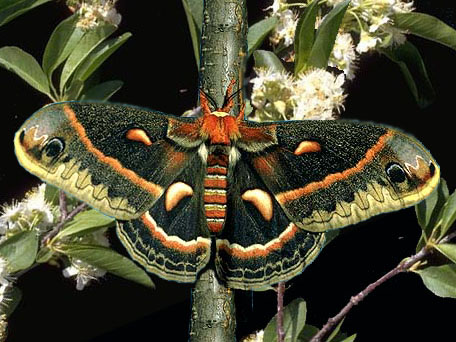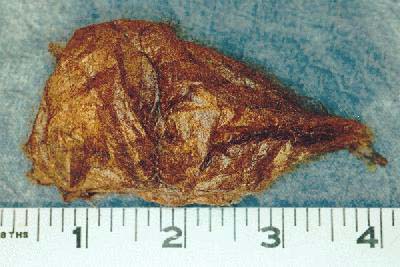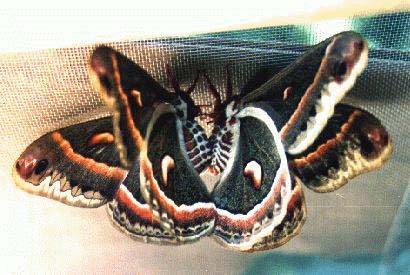The Cecropia Moth
(Hyalophora cecropia, Linnaeus, 1758)

Hyalophora cecropia moth image composited by Bill Oehlke
This site has been created by
Bill Oehlke at oehlkew@islandtelecom.com
Comments, suggestions and/or additional information are welcomed by Bill.
Become a member of
THE WORLD's
LARGEST SATURNIIDAE SITE
Pictures, information, contests, prizes,
data base search engine, free cocoons, special member only privileges
| TAXONOMY:
Superfamily: Bombycoidea, Latreille, 1802
Family: Saturniidae, Boisduval, [1837] 1834
Subfamily: Saturniinae, Boisduval, [1837] 1834
Tribe: Attacini
Genus: Hyalophora Duncan, 1841
|
MIDI MUSIC
Wind Beneath My Wings
copyright C. Odenkirk
MIDI CITY
ON.OFF
<bgsound src="wings.mid" LOOP=FOREVER>
|
DISTRIBUTION:
The cecropia moth (Hyalophora cecropia), North America's largest silkmoth with a wingspan
approaching six inches, flies in all Canadian provinces except British
Columbia and Newfoundland. In the U.S., there are some highly localized
populations reported in Washington and Utah, but generally the moth is
absent west of mid-Montana, mid-Wyoming, mid-Colorado, and mid-Texas. To the east,
is it very abundant in many states.
FLIGHT TIMES:
Like all Hyalophora species, cecropia is univoltine,i.e., there is only
one brood each year. Cecropia moths emerge
from mid May until early July in the top half of their range, and tend
to emerge from March through May in the more southern regions. Bimodal
emergences (emergence peaks that occur at distinct periods) are reported in some areas, particularly the midwest, where
approximately twenty percent of livestock emerges in late May or early
June. The remainder of the stock begins emerging about two weeks
later.
ECLOSION:

Photo by Dan MacKinnon for Bill Oehlke |
Cecropia tend to emerge in mid morning from relatively large cocoons
and have little trouble slipping
through the loose valves in both the inner and outer cocoons.
The adult moths
quickly climb to hang and inflate their wings. |
SCENTING AND MATING:
Male cecropia have been marked and are known to have flown over seven miles in
search of the wind-born female pheromone scent plume. After the couple
separates the following evening, males are on the wing again and some males
have successfully fertilized as many as three females. Hybridization occurs
with other Hyalophora species where distribution areas overlap. Here in the
northeast
H. columbia matings occur just before dawn while cecropia are more
likely to begin mating from 1:00 am until 3:30 am. Cecropia mate readily
in captivity, even in small cages.

Photo courtesy of Mike
Soroka. | The striking coloration of the wings is evident in this mating pair.
The female to the left has a heavier body and lacks the well developed
antennae of the male.
Most Hyalophora species mate in the early
morning hours, just before dawn, and remain coupled until the following
evening. Some populations, however, tend to mate shortly after
dusk.
|
EGGS, LARVAE, AND COCOONS:
Large eggs with reddish brown mottling are deposited in short rows of
three to six on host food plants. Black first instar caterpillars eat a
portion of their eggshells and tend to be gregarious, lining up side
by side on the underside of a leaf. Second instar larvae with yellow/green
bodies and black protuberances are also gregarious and progress rapidly.
Third, fourth, and fifth instar larvae are similar in their spectacular
appearance.
Most caterpillars spend approximately one week in each instar (a growth period
ended by a shedding of old skin) except
the final one of two weeks where a total length of 4.5 inches is often
reached.
Large cocoons are always fastened lengthwise to branches,
stems, trunks of the host plant or neighboring locations. Sometimes a leaf
wrap is used, but often the caterpillar will fashion its cocoon without the
aid of any props. A loose valve is spun at the pointed top of the oblong
cocoon and another valve is arranged at the top of a denser, inner
cocoon.
Click on caterpillar to see a large image and to
access a food plant list.
Click notes to access
notes on cecropia.
Return to Main Index

Click on the flashing
butterfly to show
appreciation for this site
and to visit other insect related sites.
|

|




